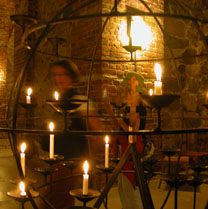

I spent a month in Helsinki for a study abroad program while in the architecture program at CU Denver. I don't think I've ever had so much fun.
|
I had the opportunity to spend a month in Finland for a study abroad program in 2005. I chose this program primarily because it gave me the opportunity to visit St. Petersburg for a weekend. St. Petersburg has been on the top of my list of places I had to see before I died for many years and it is a relatively short train ride from Helsinki. In the month that I was in Helsinki, I grew to love it though. A compact walkable city, it's beautiful (at least in the summer) and has quite a bit of history. We were there in July and got rained on twice. Pleasant summer temperatures and a sun that didn't set till about 11:00 made for a memorable trip. One of the most interesting things about Finland is the fact that it's even a country at all. With a small population of just over 5 million, it was part of Sweden until 1809 when it became an autonomous Grand Duchy of Russia. Their declaration of independence in 1917 set of a brief, but violent civil war. They remained largely neutral during W.W.II but fought two wars with Russia; the Winter War of 1939-40 in which Russia regained the Karelia region of Finland, and the Continuation War from 1941 to 1944. They actually fought along side the Nazis during the siege of Leningrad (Russia was the far bigger threat to their independence). As the tide turned against Germany during W.W.II and Germany began to make preparations to take the country, Finland signed a treaty with Russia and expelled the Nazis from northern Finland in 1944 during the Lapland War. Through a combination of luck, political savvy and fierce nationalism, Finland was able to remain autonomous (though Moscow played a significant roll in Finish politics for many years) at a time when most countries bordering Russia became Soviet republics. This, in spite of fighting four brutal wars in the first thirty years of the country's existence.
Designed by Carl Ludvig Engel and constructed over several decades in the last half of the 19th century, Senate Square is the historic heart of Helsinki. The square was patterned after St Petersburg since Finland was still part of Russia at the time. The Palace of the Council of State and the main building of Helsinki University are located here. The square is dominated by the Lutheran Cathedral which is located on a high point overlooking the square. Click here to see some great panoramas of the square.Virtual Finland is also a good source of information.
Suomenlinna is an island fortress dating back to 1748. It was constructed while Finland was still part of Sweden as a defense against Russia. Swedish military architect Augustin Otüran Ehrensvärd was the original designer. It is a classic star shaped fortress located in picturesque surroundings. It was here that Sweden surrendered Finland to the Russians in 1808. There are about 900 permanent residence on the islands and today the fort is a popular picnic site accessed by a short ferry ride from Helsinki. It became a UNESCO World Heritage site in 1991. It's a great place to get lost for a day. Website
Founded in 1909, Seurasaari is an open air museum dedicated to Finnish vernacular architecture. The museum is located on an island in metro Helsinki. It is composed of 87 structures relocated from all over Finland, representing all the provinces. The structures are mostly agrarian in nature but represent the extremes of socioeconomic status, from the Karuna Church, commissioned by a wealthy land owner, to the Niemelä tenant farm which housed what were the Finnish equivalent of sharecroppers. Perfect for a archidork/history geek like myself. Official website. While this was a working trip - graded with a paper and full sketchbook due at the end of the summer, it really felt like an extended vacation. Each day we toured neighborhoods, museums, significant architecture or different suburbs around town. We would meet for breakfast, then hop on the bus, train or subway to our daily destination.
Towards the end of the course, we embarked on a four day-three night road trip that took us out of the Helsinki area. We visited some larger cities, such as Tampere, Turku and Jyväskylä. We also stayed at a lakeside cabin in the Punkaharju region and a little guest farm in the middle of nowhere. Some of the highlights included: the church at Petajavesi, St Olaf's Castle and the iron works at Strömfors. We had the opportunity to tour many works of architecture (many by Alvar Aalto) that are familiar to archidorks everywhere; the church at Vouksenniska, Sunila workers village, The Paimio Sanitarium and Säynätsalo town hall to name a few. |
|||||||||||||||||||||||||||||||||||||||||||||||||||||||||||||||||||||||||||||||||||||||||||
| All photos on this page are originals by & copyrighted by Daren Willden, unless otherwise stated. All rights reserved. | |||||||||||||||||||||||||||||||||||||||||||||||||||||||||||||||||||||||||||||||||||||||||||









































































